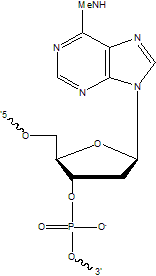Quick facts:
Availability: DNA; can be ordered on an RNA oligo
Location: 5′ and internal
Scale: 100 nmol to large scale
Purification: Standard desalt or HPLC
IDT ordering symbol: /5N6Me-dA/ or /iN6Me-dA/
N6-Methyl deoxyAdenosine (N6-Me-dA)
The N6-Methyl deoxyAdenosine (N6-Me-dA) modification consists of a methyl group at the nitrogen-6 position of a DNA base. It is a precursor of N6-methyl-2′-deoxyadenosine 3′, 5′-bisphosphate (N6MABP), a competitive antagonist specific to the P2Y1 receptors in the P2Y receptor family (see the below sidebar, P2Y receptors, to learn more). N6-Me-dA is useful in pharmacologic and research applications that examine the effects of selective inhibition of P2Y1 receptors, which appear to play a role in blood clotting.
Order N6-Me-dA as an off-catalog modification
N6-Me-dA is available from IDT as an “off-catalog” oligonucleotide modification on the 5′ base (/5N6Me-dA/) or an internal base (/iN6Me-dA/). Off-catalog modifications can be ordered through the website and are offered with yield and purity guarantees.
To order, enter your sequence online, placing the IDT ordering symbol in the desired location within your sequence. You can request N6-Me-dA oligonucleotides with standard desalt or HPLC purification.


 Processing
Processing


